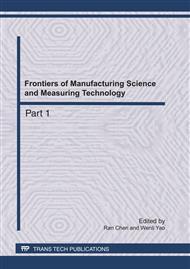[1]
S. Nemat-Nasser and H. Horii: J. of Geophys. Res. Vol. 87(B8) (1982), pp.6805-6821.
DOI: 10.1029/jb087ib08p06805
Google Scholar
[2]
Z.M. Zhu, L.G. Wang, B. Mohanty and C. Huang: Engng Fract Mech Vol. 73 (2006), pp.482-489.
Google Scholar
[3]
Z.M. Zhu: J of Engng Mech, ASCE Vol. 125 (1999), pp.1251-1258.
Google Scholar
[4]
Z.M. Zhu: Mathematics and Mechanics of Solids Vol.14 (2009), pp.727-746.
Google Scholar
[5]
Z.M. Zhu, H. Xie and S. Ji: Engineering Fracture Mechanics Vol.56 (1997), pp.647-655.
Google Scholar
[6]
Z.M. Zhu, Y. Wang, Z.T. Zhou, B.X. Li and H. Xie: Journal of Sichuan University Vol. 40 (2008), pp.13-21 (in Chinese).
Google Scholar
[7]
Z.M. Zhu, B. Mohanty and H. Xie: Int. J. Rock Mech. Min. Sci. Vol. 44 (2007), pp.412-424.
Google Scholar
[8]
Z.M. Zhu, H. Xie and B. Mohanty: Int. J. Rock Mech. Min. Sci. Vol. 45 (2008), pp.111-121.
Google Scholar
[9]
Z.M. Zhu: Int. J. Rock Mech. Min. Sci. Vol. 46 (2009), pp.1088-1096.
Google Scholar
[10]
D.E. Grady and M.E. Kipp: Int. J. Rock Mech. Min. Sci. Vol. 17 (1980), pp.147-157.
Google Scholar
[11]
F.P. Stecher and W.L. Fourney: Int. J. Rock Mech. Min. Sci. Vol. 18 (1981), pp.23-33.
Google Scholar
[12]
R. Nilson, W. Proffer and R. Duff: Int. J. Rock Mech. Min. Sci. Vol. 22 (1985), pp.3-19.
Google Scholar
[13]
F.V. Donze, J. Bouchez and S. Magnier: Int. J. Rock Mech. Min. Sci. Vol. 34 (1997), pp.1153-1163.
Google Scholar
[14]
G.W. Ma, H. Hao and Y.X. Zhou: Computers and Geotechnics Vol. 22 (1998), pp.283-303.
Google Scholar
[15]
J.W. Ma and X.M. An: Int. J. Rock Mech. Min. Sci. Vol. 45 (2008), pp.966-975.
Google Scholar
[16]
J.Q. Xiao, D.X. Ding, G. Xu and F.L. Jiang: Int. J. Rock Mech. Min. Sci. Vol. 45 (2008), pp.621-626.
Google Scholar
[17]
Z.L. Wang, Y.C. Li and J.G. Wang: Int. J. Rock Mech. Min. Sci. Vol. 45 (2008), pp.600-608.
Google Scholar
[18]
J. Zhao and J. Cai: Rock Mech. and Rock Eng. Vol. 34 (2001), p.34:3-22.
Google Scholar
[19]
Y.J. Ning, J. Yang, X.M. An and G.W. Ma: Computers and Geotechnics Vol. 38 (2011), pp.40-49.
Google Scholar


